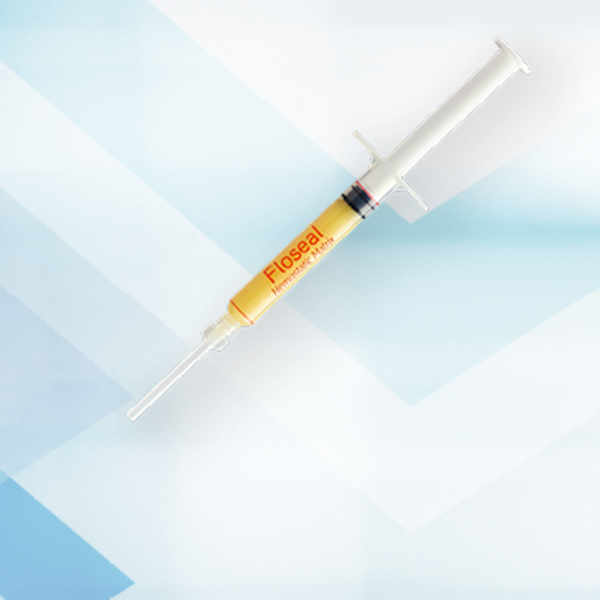Hepatobiliary Surgery
In HPB surgery, multiple factors such as treatment with antiplatelet/anticoagulant therapies as well as resection size and tissue quality can impact intraoperative blood loss1. The extent of blood loss impacts patient morbidity and mortality but may also present risk for longer term oncological outcomes2. In pancreatic surgery, the most serious complication is pancreatic leakage in the form of post-op pancreatic fistula. Baxter’s portfolio of solutions can help promote better outcomes in these challenging procedures.
Each HPB procedure provides unique challenges that can cause complications for the healing process. Here are a few examples:

FLOSEAL in Liver Resection
FLOSEAL, Baxter's flowable hemostat, is highly effective to achieve hemostasis in deep and irregular transection cavities during both open and MIS liver resection procedures. FLOSEAL, provides effective, fast hemostasis in major hepatic surgery to remove primary or metastatic tumors, controlling mild to severe bleeding from the liver edge, even in patients with cirrhotic livers5. A variety of applicator tips and cannulas are available to facilitate FLOSEAL’s application, including sites that are difficult to access.

HEMOPATCH in Liver Resection
HEMOPATCH, Baxter’s collagen pad with NHS-PEG adhesive coating, provides effective hemostasis in open and minimally invasive liver resections with largely plane transection surfaces6. Extensive vascular exposure during liver resections can increase the risk of bleeding and fistula formation. HEMOPATCH can decrease the biliary and hemorrhagic complications in liver applications, providing a strong mechanical bolster to seal even cauterized tissue7. Surgeon preferred for its flexibility/pliability and tissue adherence, HEMOPATCH handles with ease in MIS applications8.
Whipple & Distal Pancreatectomy
Postoperative pancreatic fistula (POPF) is the most common major complication after pancreatectomy and it is a potentially serious and life-threatening complication that may lead to prolonged hospital stay and increased costs9. HEMOPATCH, Baxter’s ready to use advanced patch, provides effective sealing with mechanical strength that may decrease both the incidence and severity of POPFs in both Whipple and distal pancreatectomy procedures10,11.
Portfolio of Products
Floseal Hemostatic Matrix Indication
FLOSEAL is indicated in surgical procedures as an adjunct to hemostasis when control of bleeding, ranging from oozing to spurting, by ligature or conventional procedures is ineffective or impractical.
Contraindications
Do not use FLOSEAL in patients with known allergies to materials of bovine origin.
Warnings
Do not inject or compress FLOSEAL into blood vessels.
Do not apply FLOSEAL in the absence of active blood flow, e.g., while the vessel is clamped or bypassed. Extensive intravascular clotting and even death may result.
FLOSEAL is not intended as a substitute for meticulous surgical technique and the proper application of ligatures or other conventional procedures for hemostasis.
FLOSEAL is not intended to be used as a prophylactic hemostatic agent to prevent postoperative bleeding.
Excess FLOSEAL Matrix (material not incorporated in the hemostatic clot) should always be removed by gentle irrigation from the site of application. Meticulous irrigation is required when used in, around, or in proximity to foramina in bone, areas of bony confine, the spinal cord, the brain and/or cranial nerves.
As with any implantable material, the use of FLOSEAL is not recommended in the presence of an active infection.
FLOSEAL should be used with caution in contaminated areas of the body. If signs of infection or abscess develop where FLOSEAL has been applied, re-operation may be necessary in order to remove the infected material and allow drainage.
Regardless of the type of surgical procedure, surgeons should consider the maximum swell volume of FLOSEAL, which is between 10 – 20%, after product is applied to source of bleeding and its potential effect on the surrounding anatomic areas. Maximum swell volume is achieved within about 10 minutes.
The safety and effectiveness of FLOSEAL for use in ophthalmic procedures has not been established.
FLOSEAL should not be used for controlling intrauterine post-partum bleeding or menorrhagia.
The safety and effectiveness of FLOSEAL has not been established in children and pregnant women.
Do not use FLOSEAL in the closure of skin incisions because it may interfere with the healing of the skin edges due to mechanical interposition of gelatin. The safety and effectiveness of the use of FLOSEAL Matrix as a carrier for antibiotic solutions or powders has not been established.
For safe and proper use of this device, please refer to the Instructions for Use.
CE 0123
VERWENDUNGSZWECK
HEMOPATCH ist ein resorbierbares Kollagen-Vlies zum Versiegeln und zur Hämostase.
INDIKATION
HEMOPATCH ist als Hämostatikum und chirurgischer Versiegeler bei Eingriffen angezeigt, bei denen eine Blutstillung bzw. Abdichtung gegen den Austritt anderer Körperflüssigkeiten oder von Luft mit konventionellen chirurgischen Verfahren ineffektiv oder unpraktikabel ist. HEMOPATCH kann zum Schließen von Duradefektennach traumatischen Verletzungen, Exzision, Retraktion oder Schrumpfung der Dura mater verwendet werden.
GEGENANZEIGENHEMOPATCH
nicht in Blutgefäße pressenger33 oder intravaskulär anwenden.Das Medizinprodukt darf nicht bei Patienten mit bekannter Überempfindlichkeit gegenüber Rinderproteinen oder Brillantblau (FD&C Blau Nr. 1 (Blau 1)) angewendet werden.
WARNHINWEISE
HEMOPATCH ist nicht zur Anwendung bei pulsierenden, schweren Blutungen vorgesehen.
HEMOPATCH soll nicht bei einer aktiven Infektion eingesetzt werden.Bei Anwendung in, an oder in der Nähe von Knochen-Foramina, an der Knochengrenze, am Rückenmark, am Gehirn und/oder an den Hirnnerven ist darauf zu achten, nicht zu viele Schichten aufzulegen (Kollagen kann sich bei Absorption von Flüssigkeit ausdehnen), um das Risiko neuraler Schädenvermeiden.
HEMOPATCH ist kein Ersatz für eine sorgfältige, chirurgische Arbeitsweise oder für die ordnungsgemäße Versorgung mit Ligaturen oder anderen, konventionellen Hämostase-undVersiegelungstechniken.
VORSICHTSMASSNAHMEN
Nur zum einmaligen Gebrauch. Nicht resterilisieren. Die Wiederverwendung von Einmalmaterialien birgt mögliche Infektionsrisiken.Nicht ohne Aluminium-Beutel lagern.
HEMOPATCH verwerfen, wenn die Verpackung beschädigt ist.Die mit blauen Quadraten gekennzeichnete Seite nicht auf die Applikationsstelle aufbringen. HEMOPATCH vor der Applikation nicht anfeuchten. HEMOPATCH ist selbsthaftend und nicht zum Vernähen vorgesehen.
Nicht für die Anwendung auf trockener Gewebeoberfläche oder -läsion bestimmt. NHS-PEG bildet ein haftendes Hydrogel nur in Kontakt mit Wundflüssigkeiten wie zum Beispiel Blut oder Lymphe. Bei Fehlen solcher Wundflüssigkeiten kann eine Natriumbicarbonatlösung1 (Konzentrationzwischen 4,2 und 8,4 %) verwendet werden, um das Gewebe vor der Anwendung von HEMOPATCH zu befeuchten. HEMOPATCH darf nicht auf Knochenoberflächen appliziert werden, wenn dort Kleber (z. B. Methylmethacrylat oder andere Acrylkleber) verwendet werden, um Prothesen zu fixieren. Es wurde berichtet, dass mikrofibrilläres Kollagen die Wirkung von Methylmethacrylat-Klebern beeinträchtigt, die zur Prothesen-Fixierung an der Knochenoberfläche eingesetztwurden.Die Sicherheit und Wirksamkeit von HEMOPATCH wurde nicht bei Kindern, Schwangeren und/oder stillenden Müttern untersucht.

